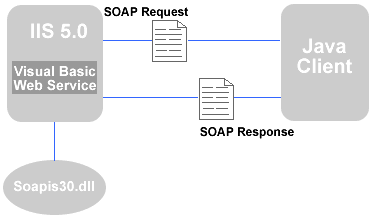Implementation
| Aim | Investigating the exposing of some ESP (VB6) data in the MAP's Java applications. Phase Two involves implementation of the theoretical concepts, researched in Phase One, on Kiwiplan's systems. |
| Background | ESP, the order processing, estimation and costing product written in Microsoft Visual Basic 6, holds information on customers, addresses and shipment requirements. MAP does not have a rich data structure in this area, but knowledge of such information would be useful. For example, the Truck Scheduling System (TSS) would like to know the opening hours for a customer's delivery address. |
| Objectives | The primary objective is to implement a web service running on the VB side that exposes customer and address information via queries by MAP customer number. A Java client, to query the VB web service, will act as a MAP client requesting information. It is hoped that finally all business objects will be exposed, however the preliminary focus is on Company amd Address objects. |
System Overview

- The Visual Basic Web Service is deployed on IIS 5.0 on a Windows 2000 machine.
- The SOAP message from the Java Application is targeted at the .wsdl file of the VB Web Service.
- The virtual directory in which the web service has been deployed has been configured to map the .wsdl extension with an ISAPI handler (SOAPIS30.dll) by the SOAPVDIR.CMD tool, which is part of the SOAP Toolkit.
- The ISAPI handler intercepts the SOAP request and invokes the appropriate function using the parameters supplied.
- The result is packaged into a SOAP message and sent back to the Java Application.
- On the Java side, the use of the AXIS API, takes care of the SOAP message creation and interpretation.
Primary Objectives
- To send an address request (Company No. and Address No.) from a Java client and receive address information from the VB Web Service.
- To send a list of address requests from a Java client and receive a list of addresses from the VB Web Service.
- Error handling and communication of the error back to the Java client through SOAP Fault messages.
Secondary Objectives
- To convert a VB Date type into a long (The VB Date format is incompatible with any known Java formats. The conversion involves calculating the number of seconds since 1st Jan 1970. This format is convenient for converting VB's Date type into Java's Date Object).
- Expanding the openDays string into an XML structure. For example,
<Sunday>false</Sunday>
<Monday>true</Monday>
… … … … … … … … … <Saturday>false</Saturday> - Assess efficiency of the system.
The VB Web Service
The VB Web Service runs on 11S 5.0 on a Windows 2000 machine. It receives requests for customer address
information. A SQL Server database is queried for the information which is then returned to the client.
More on the VB Web Service....
The Java Client
The Java Client acts like a MAP application which requires customer address information. It utilises the
AXIS API to make SOAP requests.
More on the Java Client....